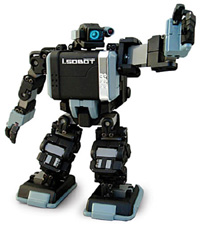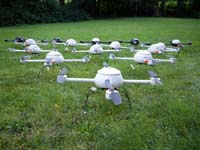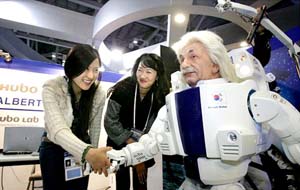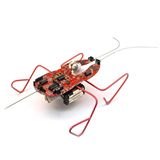 MOBILE ROBOTS MOBILE ROBOTS
 Mobile robots are not fixed to one physical location and can move in a given environment such as ground, underwater, aerial and microgravity environments. There are many applications of mobile robots from military to entertainment. Mobile robots are not fixed to one physical location and can move in a given environment such as ground, underwater, aerial and microgravity environments. There are many applications of mobile robots from military to entertainment.
Almost every universities have researches about different mobile robot projects for exploration, industry, military, security, entertainment...etc.
If we investigate the mobile robots according to their operation environments;
 Land or Home Mobile Robots: These robots are humanoid robots, some models of beam robots, some of the military robots and entertainment robots which are operate on the ground and move with wheels, tracks and legs. Land or Home Mobile Robots: These robots are humanoid robots, some models of beam robots, some of the military robots and entertainment robots which are operate on the ground and move with wheels, tracks and legs.
 Aerial Robots ( UAVs-Unmanned Aerial Vehicles ): UAVs are remote controlled or autonomous flying vehicles that have a variety of shapes, sizes, configurations and characteristics. They have six functional categories: Aerial Robots ( UAVs-Unmanned Aerial Vehicles ): UAVs are remote controlled or autonomous flying vehicles that have a variety of shapes, sizes, configurations and characteristics. They have six functional categories:

* Target and decoy: providing ground and aerial gunnery a target that simulates an enemy aircraft or missile.
* Reconnaissance: providing battlefield intelligence.
* Combat: providing attack capability for high-risk missions (see Unmanned combat air vehicle).
* Logistics: UAVs specifically designed for cargo and logistics operation.
* Research and development: used to further develop UAV technologies to be integrated into field deployed UAV aircraft.
* Civil and Commercial UAVs: UAVs specifically designed for civil and commercial applications
 Autonomous Underwater Vehicles ( AUVs): These are the autonomous robots that moves underwater and are used for military and exploration purposes. AUVs constitute part of a larger group of undersea systems known as unmanned underwater vehicles, a classification that includes non-autonomous remotely operated underwater vehicles (ROVs) -- controlled and powered from the surface by an operator/pilot via an umbilical. Autonomous Underwater Vehicles ( AUVs): These are the autonomous robots that moves underwater and are used for military and exploration purposes. AUVs constitute part of a larger group of undersea systems known as unmanned underwater vehicles, a classification that includes non-autonomous remotely operated underwater vehicles (ROVs) -- controlled and powered from the surface by an operator/pilot via an umbilical. |
 HUMANOID ROBOTS HUMANOID ROBOTS
 The humanoid robots are based on the human body. The movements, interactions, behaviors and the body parts of humanoid robots are designed as humanlike. The humanoid robots are based on the human body. The movements, interactions, behaviors and the body parts of humanoid robots are designed as humanlike.
The humanoid robots are autonomous mobil robots that can adapt to changes in its environment or itself and continue to reach its goal. Some of the humanoid robot projects include the capacity of self maintenance (recharge itself), autonomous learning or gaining new capabilities without outside assistance, adjusting strategies based on the surroundings and adapt to new situations, avoiding harmful situations to people, property, and itself or safe interacting with human beings and the environment. Because of their trying to simulate the behaviors and structure of humans, these robots are generally more complex than the other types of robots.
The humanoid robots are designed to be used in several scientific areas, to entertain, to build better orthosis and prothesis for human beings, to perform human tasks like personal assistance...etc.
|
 BEAM ROBOTS BEAM ROBOTS
 Beam is a acronym that means Biology, Electronic, Aesthetics and Mechanics. The term BEAM Robotics is a style of robotics which use simple analogue circuits in order to construct a simple, small robot whose behaviors are inspired by biological phenomena.There are various types of BEAM Robots such as: Beam is a acronym that means Biology, Electronic, Aesthetics and Mechanics. The term BEAM Robotics is a style of robotics which use simple analogue circuits in order to construct a simple, small robot whose behaviors are inspired by biological phenomena.There are various types of BEAM Robots such as:

 Audiotropes: The BEAM robots that react to sound sources. If the audiotrope goes towards the sound source it is an audiophile and if it go away from the sound source it is an audiophobe. Audiotropes: The BEAM robots that react to sound sources. If the audiotrope goes towards the sound source it is an audiophile and if it go away from the sound source it is an audiophobe.
 Radiotropes: react to radio frequency as a radiophile (towards to RF source) or as a radiophobe (away from the RF source). Radiotropes: react to radio frequency as a radiophile (towards to RF source) or as a radiophobe (away from the RF source).
  Thermotropes: reacts to heat sources as a thermophile or as a thermophobe. Thermotropes: reacts to heat sources as a thermophile or as a thermophobe.
BEAM robots have various movements and positioning mechanisms such as sitters, squirmers, sliders, crawlers, jumpers, rollers, walkers, swimmers, fliers and climbers.
|
|

